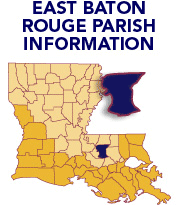East Baton Rouge - What HappenedBaton Rouge did not suffer the major devastation from Hurricanes Katrina and Rita seen in the parishes closest to Louisiana’s coast. However, the community’s quality of life and infrastructure is severely affected by an overnight influx of thousands of hurricane evacuees. Baton Rouge and the surrounding area were not prepared for the sudden population increase in such a short amount of time. Prior to the hurricanes, recent population estimates for Baton Rouge indicate 224,097 residents living in the city and more than 412,000 residents of East Baton Rouge Parish. It has been estimated that the Baton Rouge area absorbed more than 235,000 evacuees during the first two weeks after Hurricane Katrina, with additional evacuees arriving after Hurricane Rita. This influx effectively doubled the population. All 7,500 hotel rooms in Baton Rouge and an additional 1,000 rooms in the surrounding area were occupied overnight. Streets and highways - already at capacity before the storms - became bottlenecked with additional traffic. The school systems (both public and private) suffered from major increases in student population as classrooms overflowed with new students and teachers. Public school enrollment increased by 6,000 students (12 percent) within one month after the storm. Restaurants, grocery stores and other retail businesses were overwhelmed by the additional population and still lack the staff to adequately serve these new customers. After the initial population spike in September/October, the number of evacuees steadily decreased toward the end of 2005. Despite the decline in population, it is estimated that the permanent population growth of the Baton Rouge area will remain at approximately 100,000 residents, accounting for a 24 percent increase in population. This immediate growth will have long-term affects on the cost and availability of residential housing units, social services, real estate values and rents, commercial lease rates, labor costs, the availability of qualified service workers, increased transportation costs caused by congestion, and the capacity of water, sewer, and transportation infrastructure. |







